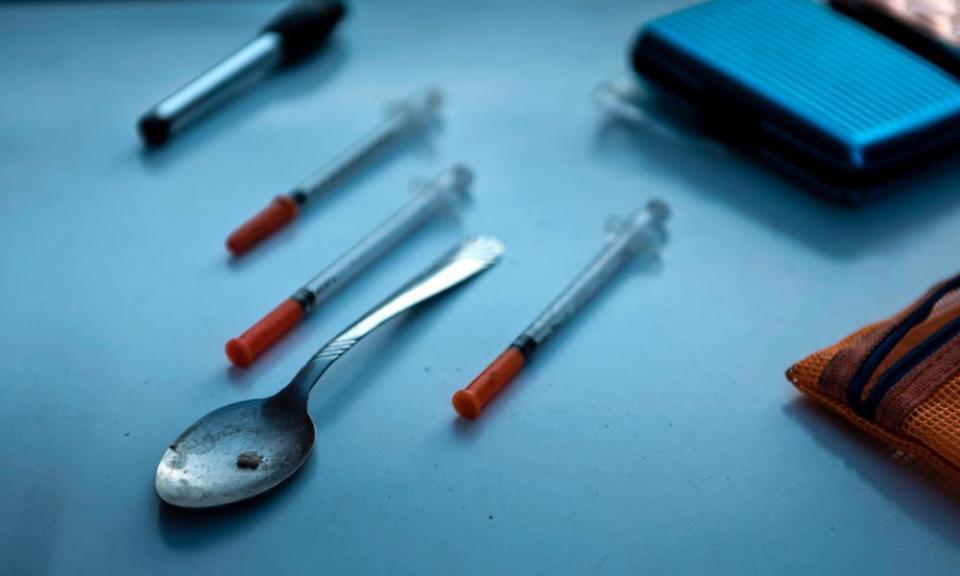Why opioid deaths are this generation’s Aids crisis | Mary O’Hara

Dr Daniel Ciccarone, a San Franciso-based public health researcher and physician told me of a recent encounter which, despite 17 years in the field, left him stunned. “I talked to a [heroin] user in West Virginia. Nice guy. Manages to keep his habit and keep his job. He’s 10 years out of high school. He’s 29. He went to his high school reunion. I kid you not – half of his high school class is gone. Died. It was mostly [opioid] pills and heroin.”
Ciccarone is on the frontline of efforts to understand and combat the US’s rapidly escalating opioid crisis and he makes no bones about the scale and impact of what he says is an unprecedented public health emergency. “We are moving beyond an epidemic. I would call it a crisis,” he says.
According to official statistics opioids, including heroin and prescription versions of the drug, killed more than 33,000 people in the US in 2015 – a record surge that is expected to see yet more increases
A New York Times analysis earlier this month estimated that overdose deaths are rising faster than ever. And, as the Guardian has reported, more US citizens die from overdoses than from gun fatalities or car crashes. It is now becoming the leading cause of death for the under-50s.
Ciccarone draws parallels with the early years of the HIV epidemic, including that those affected are vilified by wider society. Indeed, the problem is increasingly being called this generation’s Aids crisis. At its peak in 1995, that epidemic claimed 51,000 US lives.
Overdoses are spiralling partly because illicitly manufactured Fentanyl, a synthetic opioid, and similar drugs are entering the US illegally. Fentanyl is around 50 times more potent than heroin (and in some forms much more so). A combination of its strength and the fact that users aren’t aware that parts of the heroin supply have been laced with it or that it’s often used in fake prescription opioids, makes it especially lethal.
This crisis isn’t confined to the US. Canada is in the midst of its own opioid crisis. However, coinciding with last month’s Harm Reduction International conference in Montreal, the Canadian government took what was seen as a world-leading step to confront the problem. It passed legislation making it easier to open supervised injection sites so that users can inject safely and, should an overdose occur, trained medical professionals are on site to provide life-saving help such as administering anti-overdose medication. It’s the epitome of a sensible harm reduction approach that aims to reduce or eliminate harm rather than, as is often the case, punish or stigmatise users.
The magnitude of the north American crisis may be unrivalled, but there are nevertheless worrying portents for Britain. Published earlier this month, the latest annual analysis from the European Monitoring Centre for Drugs and Drug Addiction reported that deaths by overdose in the UK accounted for almost one in three overdose deaths in Europe – primarily related to heroin and other opioids. Thirty-one percent of the total 8,441 deaths recorded in 2015 were in the UK.
Critics of drugs policy in the UK have been sending warning flares for several years, highlighting the impact of austerity cuts. It is no surprise that already cash-strapped local councils – who have no legal obligation to provide addiction services – slashing support.
Niamh Eastwood, director of the UK drugs charity Release, which has been highly critical of government responses to the risk of avoidable death, says that while evidence of the Fentanyl contamination propelling the US epidemic is so far sparse in the UK, the overdose emergency requires a radical rethink of policy – and fast. Eastwood points to the government’s rejection of the Advisory Council on the Misuse of Drugs (ACMD) recommendations “to combat the rising rate of opioid-related deaths through improving drug treatment and harm reduction services” including supervised injection rooms and the “routine” availability of the anti-overdose medication, Naloxone.
There is a precedent. At the height of the HIV epidemic in the UK, the Thatcher government opened up needle exchanges for intravenous drug users.
Drug users have long been one of the most demonised and marginalised groups in society – and a low priority for policymakers. This simply can’t continue. A public health crisis and loss of life on the scale currently being witnessed warrants an immediate, and unapologetically progressive response.

 Yahoo News
Yahoo News 